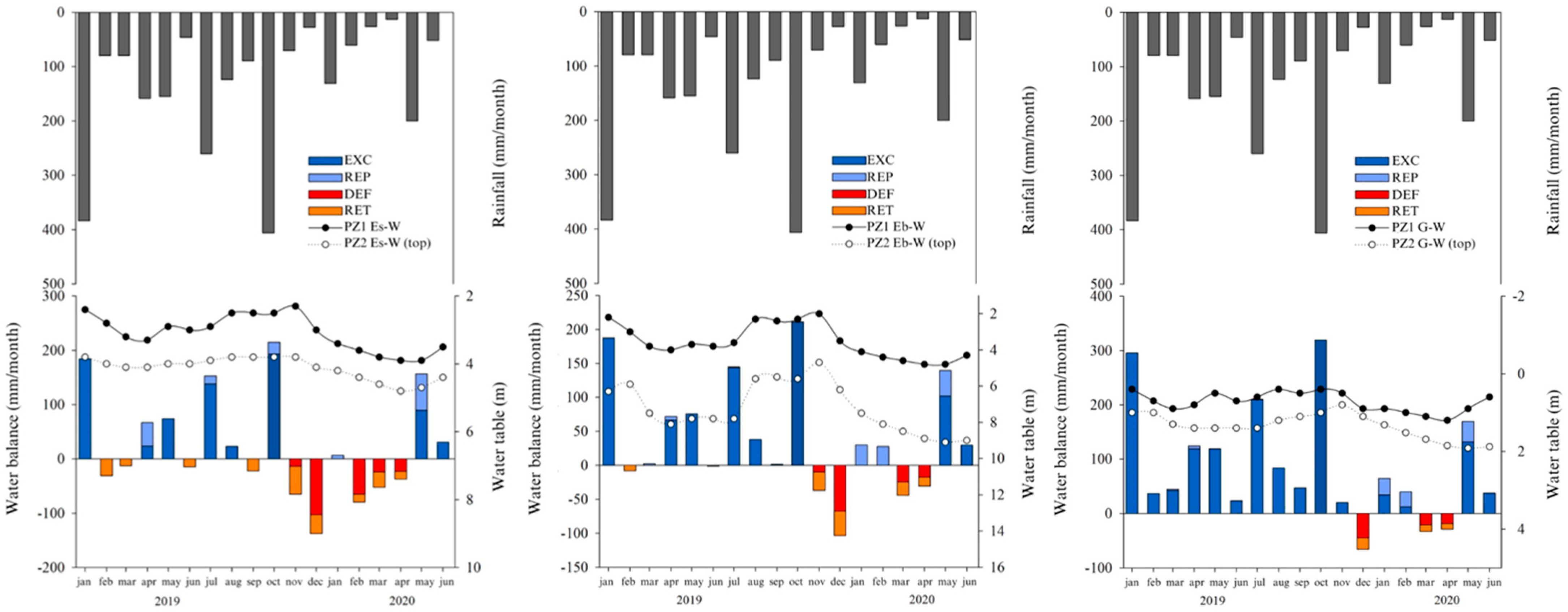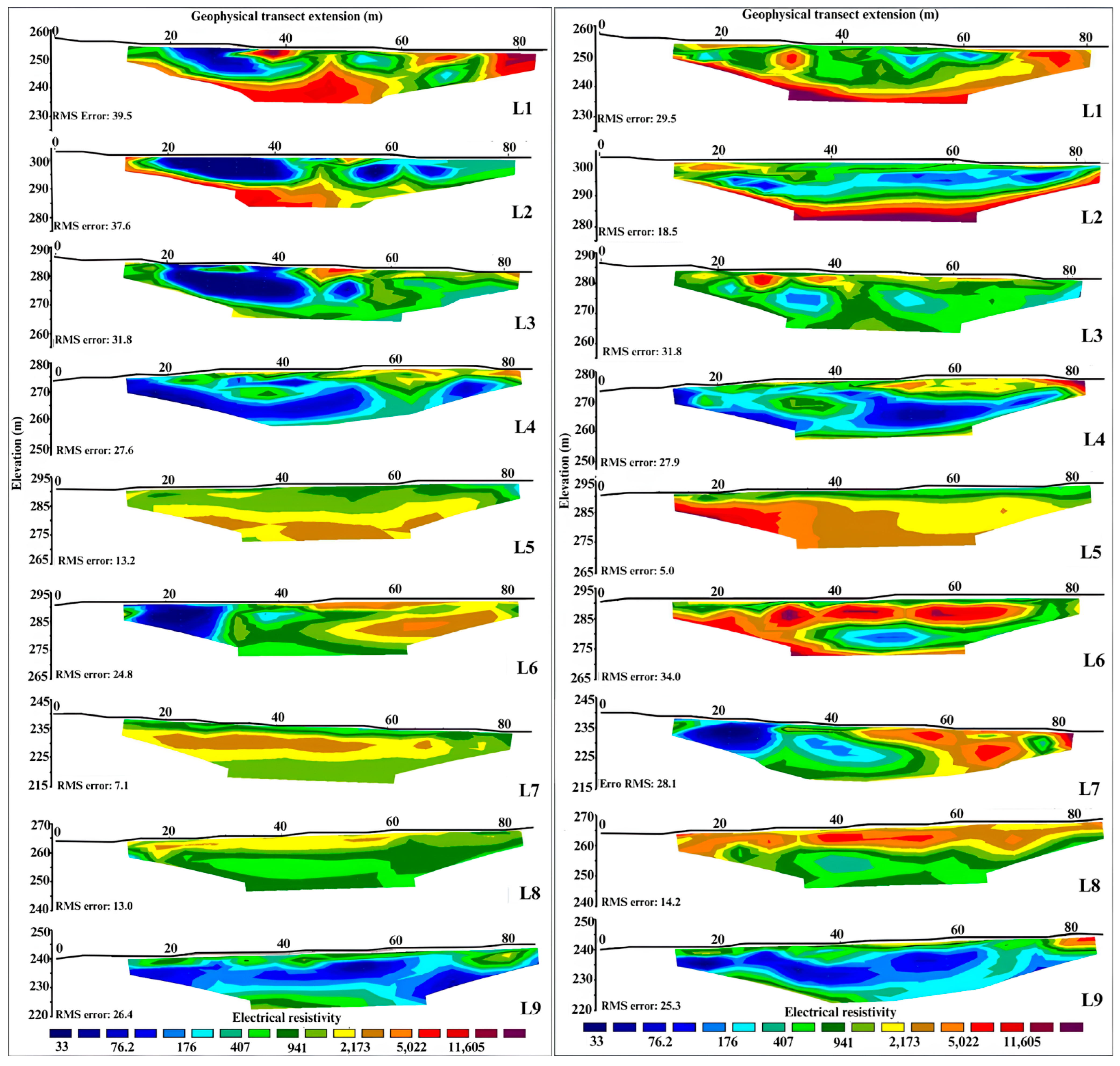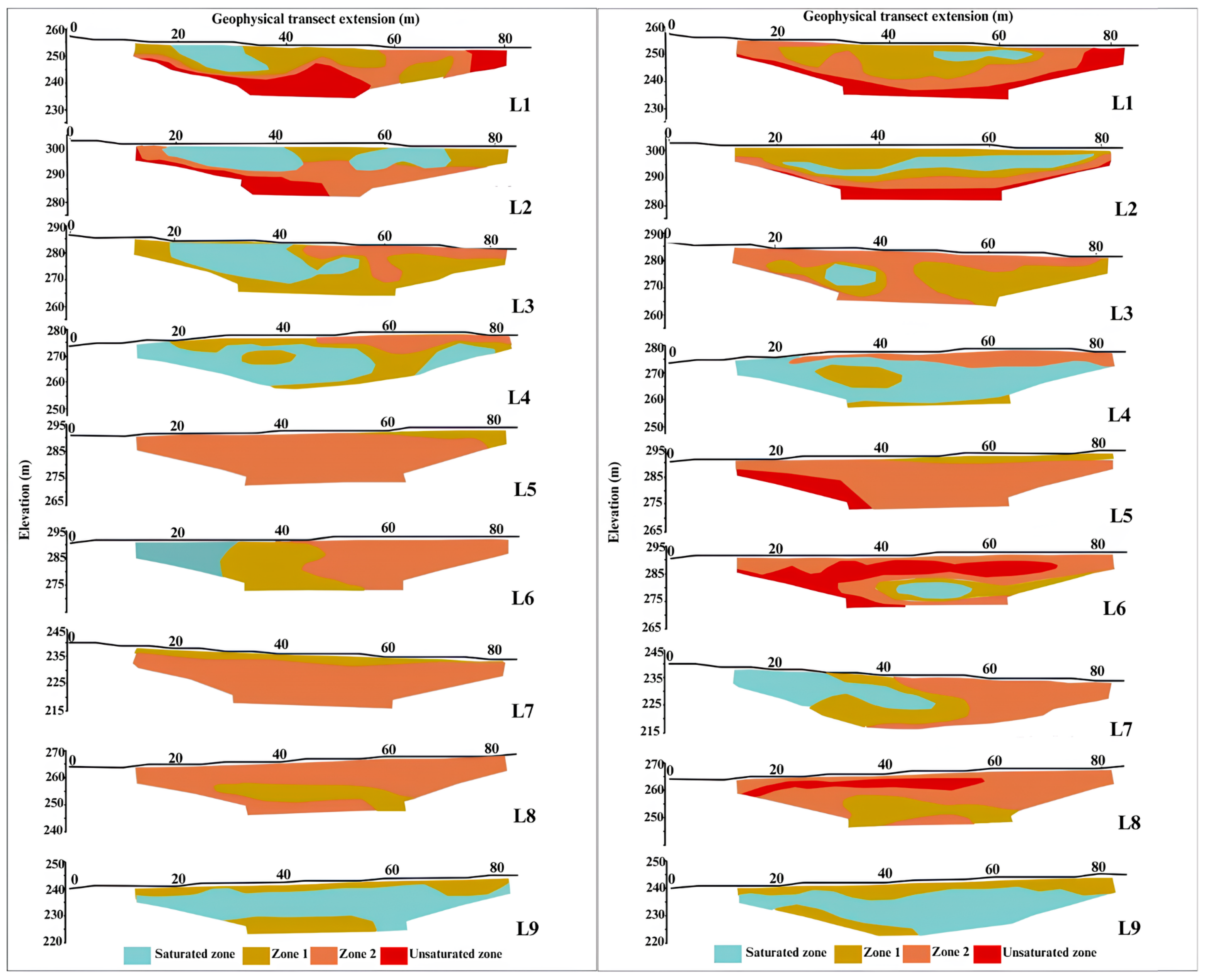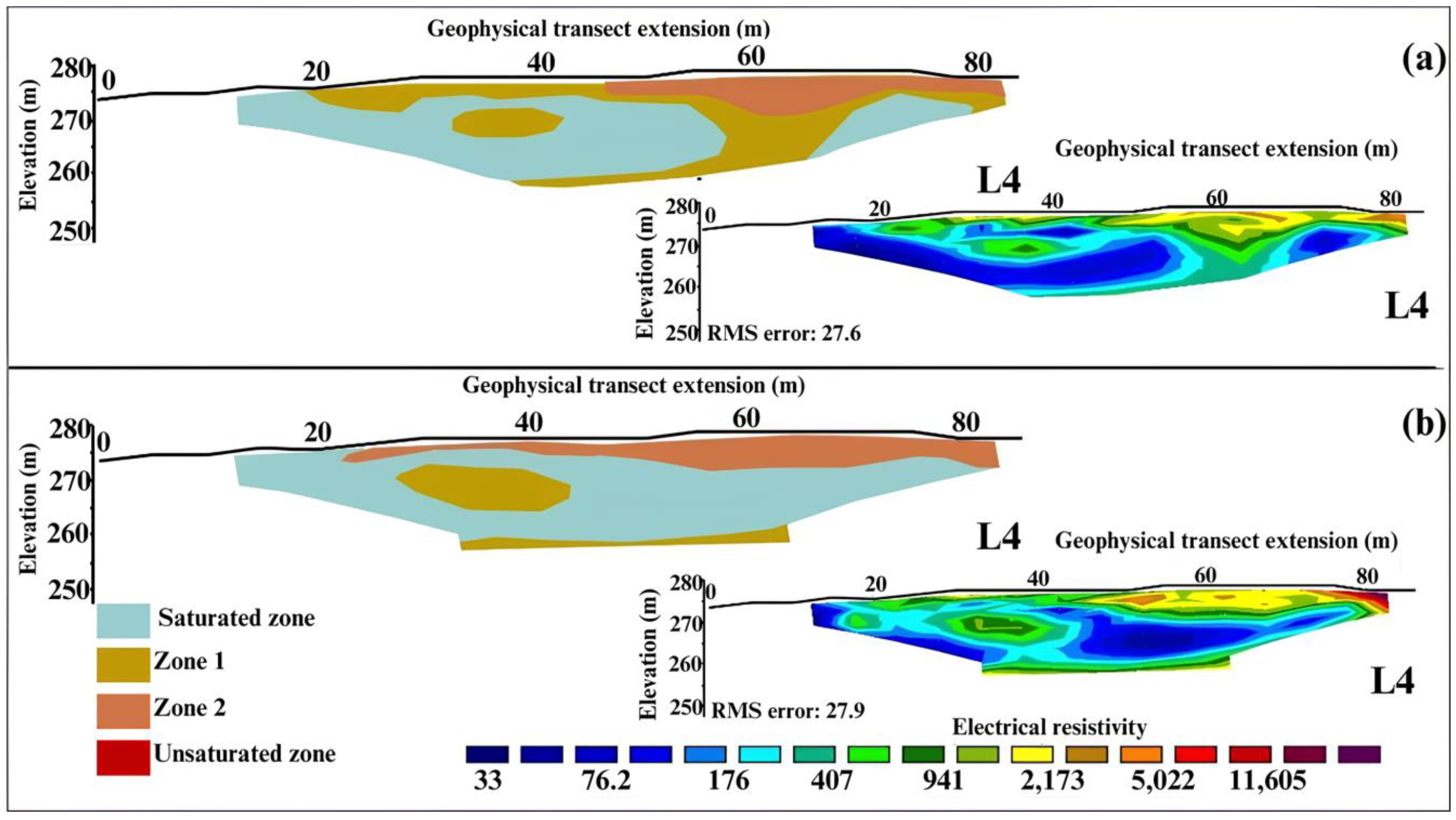Surface and Subsurface Water Impacts of Forestry and Grassland Land Use in Paired Watersheds: Electrical Resistivity Tomography and Water Balance Analysis
Abstract
:1. Introduction
2. Materials and Methods
2.1. Study Watersheds
2.2. Hydrological Monitoring
2.3. Water Balance
2.3.1. Water Balance at the Watershed Scale
2.3.2. Water Balance in the Soil Profile
2.4. Subsurface Characterization
3. Results and Discussion
3.1. Surface Hydrology
3.1.1. Water Balance at the Watershed Scale
3.1.2. Water Balance in the Soil Profile
3.2. Subsurface Characterization: Groundwater
4. Conclusions
Author Contributions
Funding
Data Availability Statement
Acknowledgments
Conflicts of Interest
References
- WWF. Forests and Climate: REDD+ at a Crossroads: Living Forests Report: Chapter 3. In Living Forests Report; WWF: Gland, Switzerland, 2011. [Google Scholar]
- Maeda, S.; Medrado, M.J.S. Plantações Florestais Comerciais e o Solo. In Plantações Florestais: Geração de Benefícios com Baixo Impacto Ambiental; Embrapa: Brasília, Brazil, 2017; pp. 21–29. [Google Scholar]
- Ferreto, D.O.C.; Reichert, J.M.; Cavalcante, R.B.L.; Srinivasan, R. Rainfall Partitioning in Young Clonal Plantations Eucalyptus Species in a Subtropical Environment, and Implications for Water and Forest Management. Int. Soil Water Conserv. Res. 2021, 9, 474–484. [Google Scholar] [CrossRef]
- Ferreto, D.O.C.; Reichert, J.M.; Cavalcante, R.B.L.; Srinivasan, R. Water Budget Fluxes in Catchments under Grassland and Eucalyptus Plantations of Different Ages. Can. J. For. Res. 2021, 51, 513–523. [Google Scholar] [CrossRef]
- Pirard, R.; Dal Secco, L.; Warman, R. Do Timber Plantations Contribute to Forest Conservation? Environ. Sci. Policy 2016, 57, 122–130. [Google Scholar] [CrossRef]
- Kröger, M. The Expansion of Industrial Tree Plantations and Dispossession in Brazil. Dev. Change 2012, 43, 947–973. [Google Scholar] [CrossRef]
- Dodet, M.; Collet, C. When Should Exotic Forest Plantation Tree Species Be Considered as an Invasive Threat and How Should We Treat Them? Biol. Invasions 2012, 14, 1765–1778. [Google Scholar] [CrossRef]
- Lorentz, K.A.; Minogue, P.J. Exotic Eucalyptus Plantations in the Southeastern US: Risk Assessment, Management and Policy Approaches. Biol. Invasions 2015, 17, 1581–1593. [Google Scholar] [CrossRef]
- Vance, E.D.; Loehle, C.; Wigley, T.B.; Weatherford, P. Scientific Basis for Sustainable Management of Eucalyptus and Populus as Short-Rotation Woody Crops in the U.S. Forests 2014, 5, 901–918. [Google Scholar] [CrossRef]
- Gush, M.B.; Scott, D.F.; Jewitt, G.P.W.; Schulze, R.E.; Hallowes, L.A.; Görgens, A.H.M. A New Approach to Modelling Streamflow Reductions Resulting from Commercial Afforestation in South Africa. S. Afr. For. J. 2002, 2002, 27–36. [Google Scholar] [CrossRef]
- Cademus, R.; Escobedo, F.J.; McLaughlin, D.; Abd-Elrahman, A. Analyzing Trade-Offs, Synergies, and Drivers among Timber Production, Carbon Sequestration, and Water Yield in Pinus elliotii Forests in Southeastern USA. Forests 2014, 5, 1409–1431. [Google Scholar] [CrossRef]
- Ferraz, S.F.B.; Lima, W.d.P.; Rodrigues, C.B. Managing Forest Plantation Landscapes for Water Conservation. For. Ecol. Manag. 2013, 301, 58–66. [Google Scholar] [CrossRef]
- Baumhardt, E. Hidrologia de Bacia de Cabeceira com Eucaliptocultura e Campo Nativo na Região da Campanha Gaúcha. Doctoral Dissertation, Universidade Federal de Santa Maria, Santa Maria, Brazil, 2014. [Google Scholar]
- Reichert, J.M.; Rodrigues, M.F.; Peláez, J.J.Z.; Lanza, R.; Minella, J.P.G.; Arnold, J.G.; Cavalcante, R.B.L. Water Balance in Paired Watersheds with Eucalyptus and Degraded Grassland in Pampa Biome. Agric. For. Meteorol. 2017, 237, 282–295. [Google Scholar] [CrossRef]
- Rodrigues, M.F.; Reichert, J.M.; Burrow, R.A.; Flores, E.M.M.; Minella, J.P.G.; Rodrigues, L.A.; Oliveira, J.S.S.; Cavalcante, R.B.L. Coarse and Fine Sediment Sources in Nested Watersheds with Eucalyptus Forest. Land Degrad. Dev. 2018, 29, 2237–2253. [Google Scholar] [CrossRef]
- Ebling, É.D.; Reichert, J.M.; Zuluaga Peláez, J.J.; Rodrigues, M.F.; Valente, M.L.; Lopes Cavalcante, R.B.; Reggiani, P.; Srinivasan, R. Event-Based Hydrology and Sedimentation in Paired Watersheds under Commercial Eucalyptus and Grasslands in the Brazilian Pampa Biome. Int. Soil Water Conserv. Res. 2021, 9, 180–194. [Google Scholar] [CrossRef]
- Dos Santos, K.F.; Reichert, J.M. Best Tillage Practices for Eucalyptus Growth and Productivity: A Review on the Brazilian Experience. Rev. Bras. Cienc. do Solo 2022, 46, e0210091. [Google Scholar] [CrossRef]
- Reichert, J.M.; Prevedello, J.; Gubiani, P.I.; Vogelmann, E.S.; Reinert, D.J.; Consensa, C.O.B.; Soares, J.C.W.; Srinivasan, R. Eucalyptus Tree Stockings Effect on Water Balance and Use Efficiency in Subtropical Sandy Soil. For. Ecol. Manag. 2021, 497, 119473. [Google Scholar] [CrossRef]
- Cavalli, J.P.; Reichert, J.M.; Rodrigues, M.F.; de Araújo, E.F. Composition and Functional Soil Properties of Arenosols and Acrisols: Effects on Eucalyptus Growth and Productivity. Soil Tillage Res. 2020, 196, 104439. [Google Scholar] [CrossRef]
- de Bastos, F.; Reichert, J.M.; Minella, J.P.G.; Rodrigues, M.F. Strategies for Identifying Pollution Sources in a Headwater Catchment Based on Multi-Scale Water Quality Monitoring. Environ. Monit. Assess. 2021, 193, 169. [Google Scholar] [CrossRef]
- Conant, B.; Robinson, C.E.; Hinton, M.J.; Russell, H.A.J. A Framework for Conceptualizing Groundwater-Surface Water Interactions and Identifying Potential Impacts on Water Quality, Water Quantity, and Ecosystems. J. Hydrol. 2019, 574, 609–627. [Google Scholar] [CrossRef]
- Chandra, S.; Dewandel, B.; Dutta, S.; Ahmed, S. Geophysical Model of Geological Discontinuities in a Granitic Aquifer: Analyzing Small Scale Variability of Electrical Resistivity for Groundwater Occurrences. J. Appl. Geophys. 2010, 71, 137–148. [Google Scholar] [CrossRef]
- McLachlan, P.J.; Chambers, J.E.; Uhlemann, S.S.; Binley, A. Geophysical Characterisation of the Groundwater–Surface Water Interface. Adv. Water Resour. 2017, 109, 302–319. [Google Scholar] [CrossRef]
- Mansour, K.; Omar, K.; Ali, K.; Abdel Zaher, M. Geophysical Characterization of the Role of Fault and Fracture Systems for Recharging Groundwater Aquifers from Surface Water of Lake Nasser. NRIAG J. Astron. Geophys. 2018, 7, 99–106. [Google Scholar] [CrossRef]
- Knight, A.C.; Werner, A.D.; Irvine, D.J. Combined Geophysical and Analytical Methods to Estimate Offshore Freshwater Extent. J. Hydrol. 2019, 576, 529–540. [Google Scholar] [CrossRef]
- Ezema, O.K.; Ibuot, J.C.; Obiora, D.N. Geophysical Investigation of Aquifer Repositories in Ibagwa Aka, Enugu State, Nigeria, Using Electrical Resistivity Method. Groundw. Sustain. Dev. 2020, 11, 100458. [Google Scholar] [CrossRef]
- Parsekian, A.D.; Singha, K.; Minsley, B.J.; Holbrook, W.S.; Slater, L. Multiscale Geophysical Imaging of the Critical Zone. Rev. Geophys. 2015, 53, 1–26. [Google Scholar] [CrossRef]
- Chambers, J.E.; Gunn, D.A.; Wilkinson, P.B.; Meldrum, P.I.; Haslam, E.; Holyoake, S.; Kirkham, M.; Kuras, O.; Merritt, A.; Wragg, J. 4D Electrical Resistivity Tomography Monitoring of Soil Moisture Dynamics in an Operational Railway Embankment. Near Surf. Geophys. 2014, 12, 61–72. [Google Scholar] [CrossRef]
- de Oliveira, M.V.G.; Moreira, C.A.; Netto, L.G.; Nascimento, M.M.P.F.; Sampaio, B.V. Geophysical and Geological Surveys to Understand the Hydrogeological Behavior in an Outcrop Area of the Guarani Aquifer System, in Brazil. Environ. Chall. 2022, 6, 100448. [Google Scholar] [CrossRef]
- Moreira, C.A.; Helene, L.P.I.; Rosa, F.T.G.; Hansen, M.A.F.; Malagutti Filho, W.; Dourado, J.C. Comparative Analysis among Electrical Resistivity Tomography Arrays in the Reconnaissance of Flow Structure in Fractures Aquifer in Caçapava Do Sul (RS). Pesqui. Geocienc. 2019, 46, e0710. [Google Scholar] [CrossRef]
- Myhre, G.; Alterskjær, K.; Stjern, C.W.; Hodnebrog; Marelle, L.; Samset, B.H.; Sillmann, J.; Schaller, N.; Fischer, E.; Schulz, M.; et al. Frequency of Extreme Precipitation Increases Extensively with Event Rareness under Global Warming. Sci. Rep. 2019, 9, 16063. [Google Scholar] [CrossRef]
- Tfwala, C.M.; van Rensburg, L.D.; Bello, Z.A. Groundwater Contribution to Transpiration of Trees under Wet and Dry Soil Conditions. Irrig. Drain. 2021, 70, 42–51. [Google Scholar] [CrossRef]
- de Bastos, F.; Carlos, J.; Júnior, D.D.; Ebling, É.D.; Neumann, M.; Reichert, J.M.; Neumann, M. Efficiency of Water Use by Eucalyptus spp. for Water Conservation and Sustainable Forest Production. Hydrol. Sci. J. 2024, 69, 844–860. [Google Scholar] [CrossRef]
- Alvares, C.A.; Stape, J.L.; Sentelhas, P.C.; De Moraes Gonçalves, J.L.; Sparovek, G. Köppen’s Climate Classification Map for Brazil. Meteorol. Z. 2013, 22, 711–728. [Google Scholar] [CrossRef] [PubMed]
- Moreno, J.A. Clima Do Rio Grande Do Sul. In Boletim Geográfico do Estado do Rio Grande do Sul; Secretaria de Planejamento, Governança e Gestão: Porto Alegre, Brazil, 1961; Volume 11, pp. 2446–7251. [Google Scholar]
- Reichert, J.M.; de Deus Junior, J.C.; Borges Junior, N.; Cavalcante, R.B.L. Experimental Catchments in the Pampa Biome: Database on Hydrology in Grasslands and Eucalyptus Plantations in Subtropical Brazil. Hydrol. Process. 2021, 35, e14285. [Google Scholar] [CrossRef]
- USDA—United States Department of Agriculture. Keys to Soil Taxonomy; USDA: Washington, DC, USA, 2014.
- Dos Santos, H.G.; Jacomine, P.K.T.; Anjos, L.H.C.; Oliveira, V.Á.; Oliveira, J.B.; Coelho, M.R.; Lumbreras, J.F.; Cunha, T.J.F. Sistema Brasileiro de Classificação de Solos, 3rd ed.; Empresa Brasileira de Pesquisa Agropecuária (EMBRAPA): Brasília, Brazil, 2013; 353p, ISBN 85-85864-19-2. [Google Scholar]
- Allen, R.G.; Pereira, L.S.; Raes, D.; Smith, M. Crop Evapotranspiration—Guidelines for Computing Crop Water Requirements—FAO Irrigation and Drainage Paper 56; FAO: Rome, Italy, 1998. [Google Scholar] [CrossRef]
- Thornthwaite, C.W.; Mather, J.R. The Water Balance; Drexel Institute of Technology—Laboratory of Climatology: Centerton, NJ, USA, 1955. [Google Scholar]
- ABNT NBR 15.935; Investigações Ambientais—Aplicação de Métodos Geofísicos. ABNT: Rio de Janeiro, Brazil, 2011.
- Degroot-Hedlin, C.; Constable, S. Occam’s Inversion to Generate Smooth, Two-Dimensional Models from Magnetotelluric Data. Geophysics 1990, 55, 1613–1624. [Google Scholar] [CrossRef]
- Loke, M. Rapid 2-D Resistivity & IP Inversion Using the Least-Squares Method; Geotomo Software: Penang, Malaysia, 2019. [Google Scholar]
- Resende, R.T.; Soares, A.A.V.; Forrester, D.I.; Marcatti, G.E.; dos Santos, A.R.; Takahashi, E.K.; e Silva, F.F.; Grattapaglia, D.; Resende, M.D.V.; Leite, H.G. Environmental Uniformity, Site Quality and Tree Competition Interact to Determine Stand Productivity of Clonal Eucalyptus. For. Ecol. Manag. 2018, 410, 76–83. [Google Scholar] [CrossRef]
- de Mattos, E.M.; Binkley, D.; Campoe, O.C.; Alvares, C.A.; Stape, J.L. Variation in Canopy Structure, Leaf Area, Light Interception and Light Use Efficiency among Eucalyptus Clones. For. Ecol. Manag. 2020, 463, 118038. [Google Scholar] [CrossRef]
- Migacz, I.P.; Raeski, P.A.; de Almeida, V.P.; Raman, V.; Nisgoski, S.; de Muniz, G.I.B.; Farago, P.V.; Khan, I.A.; Budel, J.M. Comparative Leaf Morpho-Anatomy of Six Species of Eucalyptus Cultivated in Brazil. Rev. Bras. Farmacogn. 2018, 28, 273–281. [Google Scholar] [CrossRef]
- Dresel, P.E.; Dean, J.F.; Perveen, F.; Webb, J.A.; Hekmeijer, P.; Adelana, S.M.; Daly, E. Effect of Eucalyptus Plantations, Geology, and Precipitation Variability on Water Resources in Upland Intermittent Catchments. J. Hydrol. 2018, 564, 723–739. [Google Scholar] [CrossRef]
- Pinheiro, R.C.; de Deus Junior, J.C.; Nouvellon, Y.; Campoe, O.C.; Stape, J.L.; Aló, L.L.; Guerrini, I.A.; Jourdan, C.; Laclau, J.P. A Fast Exploration of Very Deep Soil Layers by Eucalyptus Seedlings and Clones in Brazil. For. Ecol. Manag. 2016, 366, 143–152. [Google Scholar] [CrossRef]
- de Barros Ferraz, S.F.; Rodrigues, C.B.; Garcia, L.G.; Alvares, C.A.; de Paula Lima, W. Effects of Eucalyptus Plantations on Streamflow in Brazil: Moving beyond the Water Use Debate. For. Ecol. Manag. 2019, 453, 117571. [Google Scholar] [CrossRef]
- Almeida, A.C.; Soares, J.V.; Landsberg, J.J.; Rezende, G.D. Growth and Water Balance of Eucalyptus Grandis Hybrid Plantations in Brazil during a Rotation for Pulp Production. For. Ecol. Manag. 2007, 251, 10–21. [Google Scholar] [CrossRef]
- Dos Reis, G.G.; Reis, M.G.F. Fisiologia da Brotação de Eucalipto com Ênfase nas Suas Relações Hídricas; IPEF—Instituto de Pesquisas e Estudos Florestais: Piracicaba, Brazil, 1997. [Google Scholar]
- Christina, M.; Nouvellon, Y.; Laclau, J.P.; Stape, J.L.; Bouillet, J.P.; Lambais, G.R.; le Maire, G. Importance of Deep Water Uptake in Tropical Eucalypt Forest. Funct. Ecol. 2017, 31, 509–519. [Google Scholar] [CrossRef]
- Eliades, M.; Bruggeman, A.; Lubczynski, M.W.; Christou, A.; Camera, C.; Djuma, H. The Water Balance Components of Mediterranean Pine Trees on a Steep Mountain Slope during Two Hydrologically Contrasting Years. J. Hydrol. 2018, 562, 712–724. [Google Scholar] [CrossRef]






| Variable | Eb-W | Es-W | G-W | |||
|---|---|---|---|---|---|---|
| Wet | Dry | Wet | Dry | Wet | Dry | |
| P (mm) | 1098.50 | 478.5 | 1098.50 | 478.5 | 1098.50 | 478.5 |
| Q (mm) | 225.8 | 22.7 * | 229.8 ** | 66.6 | 649.6 *** | 84.7 *** |
| Int (mm) | 248.4 | 108.3 | 356.1 | 154.9 | 149.4 | 65.1 |
| ETa (mm) | 624.3 | 347.5 | 512.6 | 257 | 299.5 | 328.7 |
| End of Wet Period (19 November 2019) | End of Dry Period (4 June 2020) | ||
|---|---|---|---|
| Transection 1 (%) G-W | Transection 1 (%) G-W | ||
| Saturated zone | 12.7 | Saturated zone | 5.3 |
| Zone 1 | 29.4 | Zone 1 | 33.0 |
| Zone 2 | 28.3 | Zone 2 | 37.4 |
| Unsaturated zone | 29.6 | Unsaturated zone | 24.3 |
| Transection 2 (%) G-W | Transection 2 (%) G-W | ||
| Saturated zone | 33.9 | Saturated zone | 22.2 |
| Zone 1 | 15.5 | Zone 1 | 40.3 |
| Zone 2 | 35.8 | Zone 2 | 21.5 |
| Unsaturated zone | 14.8 | Unsaturated zone | 16.0 |
| Transection 3 (%) G-W | Transection 3 (%) G-W | ||
| Saturated zone | 33.8 | Saturated zone | 5.8 |
| Zone 1 | 47.5 | Zone 1 | 40.3 |
| Zone 2 | 18.7 | Zone 2 | 53.9 |
| Unsaturated zone | - | Unsaturated zone | - |
| Transection 4 (%) Es-W | Transection 4 (%) Es-W | ||
| Saturated zone | 53.3 | Saturated zone | 64.6 |
| Zone 1 | 32.1 | Zone 1 | 15.0 |
| Zone 2 | 14.6 | Zone 2 | 20.4 |
| Unsaturated zone | - | Unsaturated zone | - |
| Transection 5 (%) Es-W | Transection 5 (%) Es-W | ||
| Saturated zone | - | Saturated zone | - |
| Zone 1 | 6.8 | Zone 1 | 9.6 |
| Zone 2 | 93.2 | Zone 2 | 77.5 |
| Unsaturated zone | - | Unsaturated zone | 12.9 |
| Transection 6 (%) Eb-W | Transection 6 (%) Eb-W | ||
| Saturated zone | - | Saturated zone | 6.9 |
| Zone 1 | 13.7 | Zone 1 | 13.7 |
| Zone 2 | 86.3 | Zone 2 | 44.5 |
| Unsaturated zone | - | Unsaturated zone | 34.9 |
| Transection 7 (%) Es-W | Transection 7 (%) Es-W | ||
| Saturated zone | 18.5 | Saturated zone | 29.5 |
| Zone 1 | 33.7 | Zone 1 | 26.9 |
| Zone 2 | 47.8 | Zone 2 | 43.6 |
| Unsaturated zone | - | Unsaturated zone | - |
| Transection 8 (%) Eb-W | Transection 8 (%) Eb-W | ||
| Saturated zone | - | Saturated zone | - |
| Zone 1 | 21.0 | Zone 1 | 22.5 |
| Zone 2 | 79.0 | Zone 2 | 63.9 |
| Unsaturated zone | - | Unsaturated zone | 13.6 |
| Transection 9 (%) Eb-W | Transection 9 (%) Eb-W | ||
| Saturated zone | 64.7 | Saturated zone | 63.6 |
| Zone 1 | 35.3 | Zone 1 | 36.4 |
| Zone 2 | - | Zone 2 | - |
| Unsaturated zone | - | Unsaturated zone | - |
Disclaimer/Publisher’s Note: The statements, opinions and data contained in all publications are solely those of the individual author(s) and contributor(s) and not of MDPI and/or the editor(s). MDPI and/or the editor(s) disclaim responsibility for any injury to people or property resulting from any ideas, methods, instructions or products referred to in the content. |
© 2024 by the authors. Licensee MDPI, Basel, Switzerland. This article is an open access article distributed under the terms and conditions of the Creative Commons Attribution (CC BY) license (https://creativecommons.org/licenses/by/4.0/).
Share and Cite
de Souza, É.E.B.; de Bastos, F.; da Cunha Kemerich, P.D.; Zago, M.M.; Ebling, É.D.; de Araujo, E.F.; Antonino, A.C.D.; Reichert, J.M. Surface and Subsurface Water Impacts of Forestry and Grassland Land Use in Paired Watersheds: Electrical Resistivity Tomography and Water Balance Analysis. Water 2024, 16, 2191. https://doi.org/10.3390/w16152191
de Souza ÉEB, de Bastos F, da Cunha Kemerich PD, Zago MM, Ebling ÉD, de Araujo EF, Antonino ACD, Reichert JM. Surface and Subsurface Water Impacts of Forestry and Grassland Land Use in Paired Watersheds: Electrical Resistivity Tomography and Water Balance Analysis. Water. 2024; 16(15):2191. https://doi.org/10.3390/w16152191
Chicago/Turabian Stylede Souza, Éricklis Edson Boito, Franciele de Bastos, Pedro Daniel da Cunha Kemerich, Marieli Machado Zago, Éderson Diniz Ebling, Elias Frank de Araujo, Antonio Celso Dantas Antonino, and José Miguel Reichert. 2024. "Surface and Subsurface Water Impacts of Forestry and Grassland Land Use in Paired Watersheds: Electrical Resistivity Tomography and Water Balance Analysis" Water 16, no. 15: 2191. https://doi.org/10.3390/w16152191





